
There’s a very dangerous scam going full force right now that puts every penny in your bank account at immediate risk.
Scammers have been installing skimming devices on the card readers that are built into ATMs for years, and now they have branched out to the card readers on gas pumps.
Truth be told, there are probably skimmers in use on some of the gas pumps in your own town at this very minute.
If you fail to notice a skimmer on the pump you’re planning to use, the device will intercept your card info and transmit it wirelessly to the crook (who is probably watching you from inside a nearby vehicle).
Once the crook has your stolen card info he’ll either sell the info to another scammer or use it himself to create a fake duplicate card, then use the fake card to withdraw cash from your bank account or make purchases online.
The most brazen thieves will even use the fake card to purchase items at local stores with YOUR money!
These illicit card skimmers are getting smaller and harder to recognize all the time, but if you look closely you’ll still probably be able to tell if one is present on the ATM or gas pump you’re planning to use.
These devices are usually placed over top of the real carder, but some of the smallest ones are actually inserted inside the little cavity that houses the real card reader that’s built into the ATM or gas pump.
Many skimmers also work in conjunction with a camera that allows the crook to actually watch you type in your card’s PIN as you enter it, making it even easier for him to steal your hard-earned money.
These illicit devices (skimmer and camera combo) can be purchased online for less than $20 each, hence the explosion in their usage across the country.
Luckily, there are a couple of things you can do to greatly reduce the chance that you’ll fall victim to the “card skimmer” scam:
1 – Closely inspect the card reader on every ATM and gas pump you plan to use BEFORE inserting your card.
Look closely to see if anything at all looks odd, out of place or simply doesn’t belong. Also try wiggling the card reader to see if there is even the slighted movement.
If you notice anything at all that doesn’t look right or the card reader simply doesn’t look and feel like it was actually built into the machine, don’t insert your card! Instead, simply drive to a different gas station or choose a different ATM.
If the card reader appears to be legitimate you can go ahead and use that ATM or gas pump, but it would still be wise to keep a close check on your account just in case your card was compromised by a skimmer that you couldn’t see.
2 – Pull out your smartphone and turn on Bluetooth. Since card skimmers typically transmit the card info they steal to the scammer’s device via Bluetooth, if a skimmer is in use at your pump (or a nearby pump) you’ll probably see you phone attempting to “pair” with an unfamiliar device.
If you see an attempted pairing taking place I recommend that you quickly turn Bluetooth off, then get in your vehicle and find another gas station.
3 – If your examination of the card reader and and Bluetooth check fail to turn up any evidence that a skimmer has been installed on the machine, go ahead and use it but be sure to cover the hand you use to type in your PIN with your other hand to prevent an illicit camera from seeing which numbers you type in.
That way if there’s a skimmer installed and you failed to recognize it, at least the scammer won’t be able to use your card at an ATM to quickly drain all the cash from your account.
Now all of the above being said, there’s no guarantee that you’ll be able to spot every skimming device in use today. As I mentioned earlier, these devices are getting smaller and harder to detect all the time.
If you do happen to fall victim to this scam, call the phone number on the back of your card immediately and report the fraud so the bank can quickly cancel the card and issue you a new one.
Calling as promptly as possible will also allow the bank’s security department to begin investigating the fraudulent transaction right away and (hopefully) prevent another fraudulent transaction from taking place.
Depending on the type of card used (i.e. Credit or ATM/Debit) and how long you waited to report the fraudulent transaction, your liability for the amount stolen could range anywhere from $0 to every penny in your bank account.
That’s why if your bank offers the option you should sign up for text message and email alerts for your bank card.
These virtually instant alerts are sent to your mobile phone and/or email immediately after every purchase and/or withdrawal has been completed. If you receive an alert about a transaction you didn’t make, contact your bank immediately and report it.
This page on the FTC website explains how much you’ll end up actually losing, depending on the situation.
Bottom line: Card skimmers are now being used nationwide to intercept and steal your bank card information and PIN. Protect yourself as much as possible by using the tips mentioned above.